Mental Health Case Study: Paranoid Schizophrenia Analysis
VerifiedAdded on 2022/08/12
|19
|5907
|46
Case Study
AI Summary
This case study focuses on a 26-year-old male, AB, diagnosed with paranoid schizophrenia. The study details AB's background, including childhood experiences of bullying and the impact of his grandmother's death, which contributed to his current mental health condition. The essay outlines the symptoms, including auditory hallucinations and delusional thoughts, and analyzes the impact on his family. The core of the case study involves a discussion of screening, assessment, and care plan components, emphasizing a patient-centered approach. The case study highlights the importance of empathetic communication, the use of assessment tools, and the development of a multidisciplinary care approach. The patient's experiences are explored, including his perceptions of workplace interactions and the role of auditory hallucinations in reinforcing his delusions. The case study underscores the need for a comprehensive understanding of the patient's lived experiences and the development of effective mental healthcare strategies.
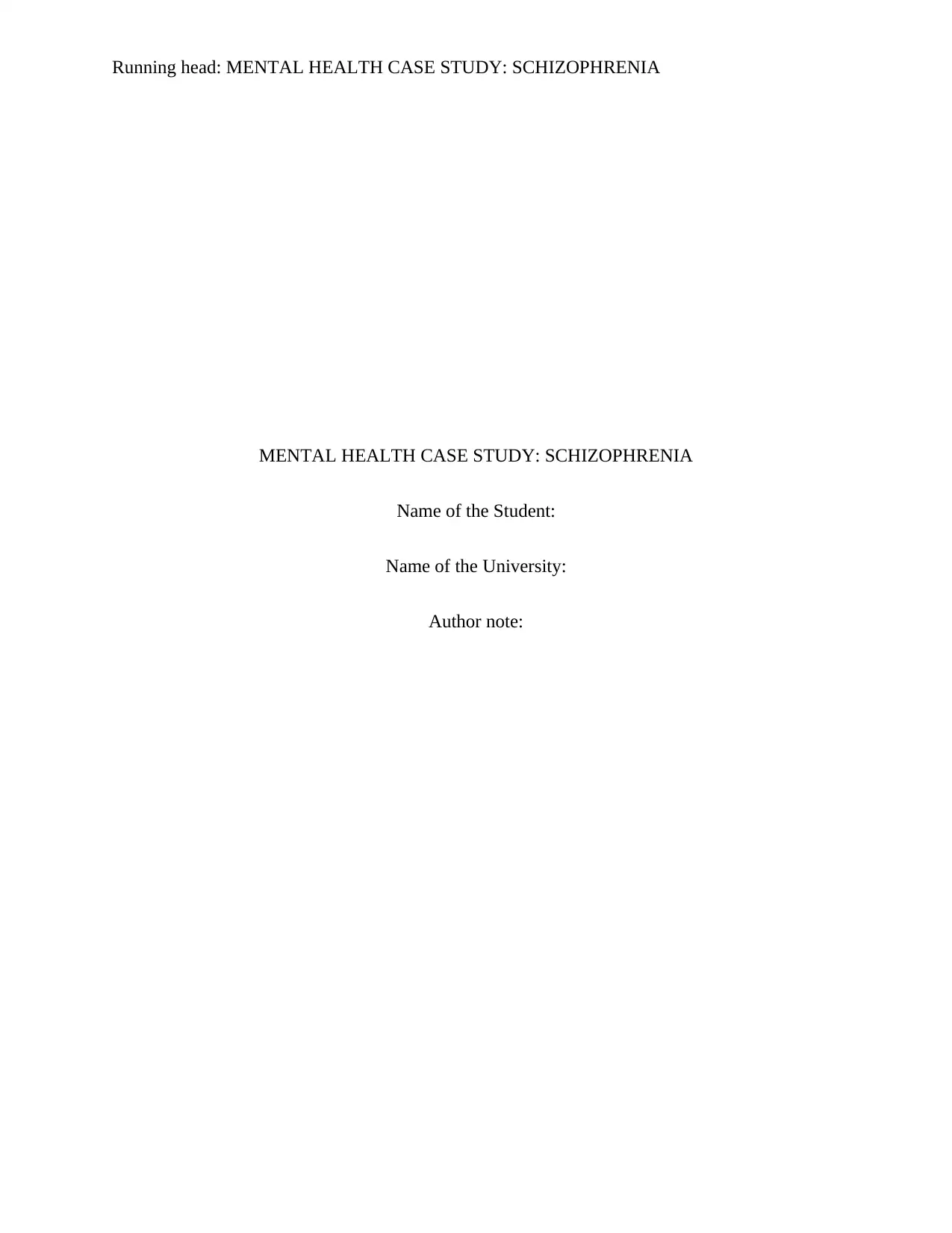
Running head: MENTAL HEALTH CASE STUDY: SCHIZOPHRENIA
MENTAL HEALTH CASE STUDY: SCHIZOPHRENIA
Name of the Student:
Name of the University:
Author note:
MENTAL HEALTH CASE STUDY: SCHIZOPHRENIA
Name of the Student:
Name of the University:
Author note:
Paraphrase This Document
Need a fresh take? Get an instant paraphrase of this document with our AI Paraphraser
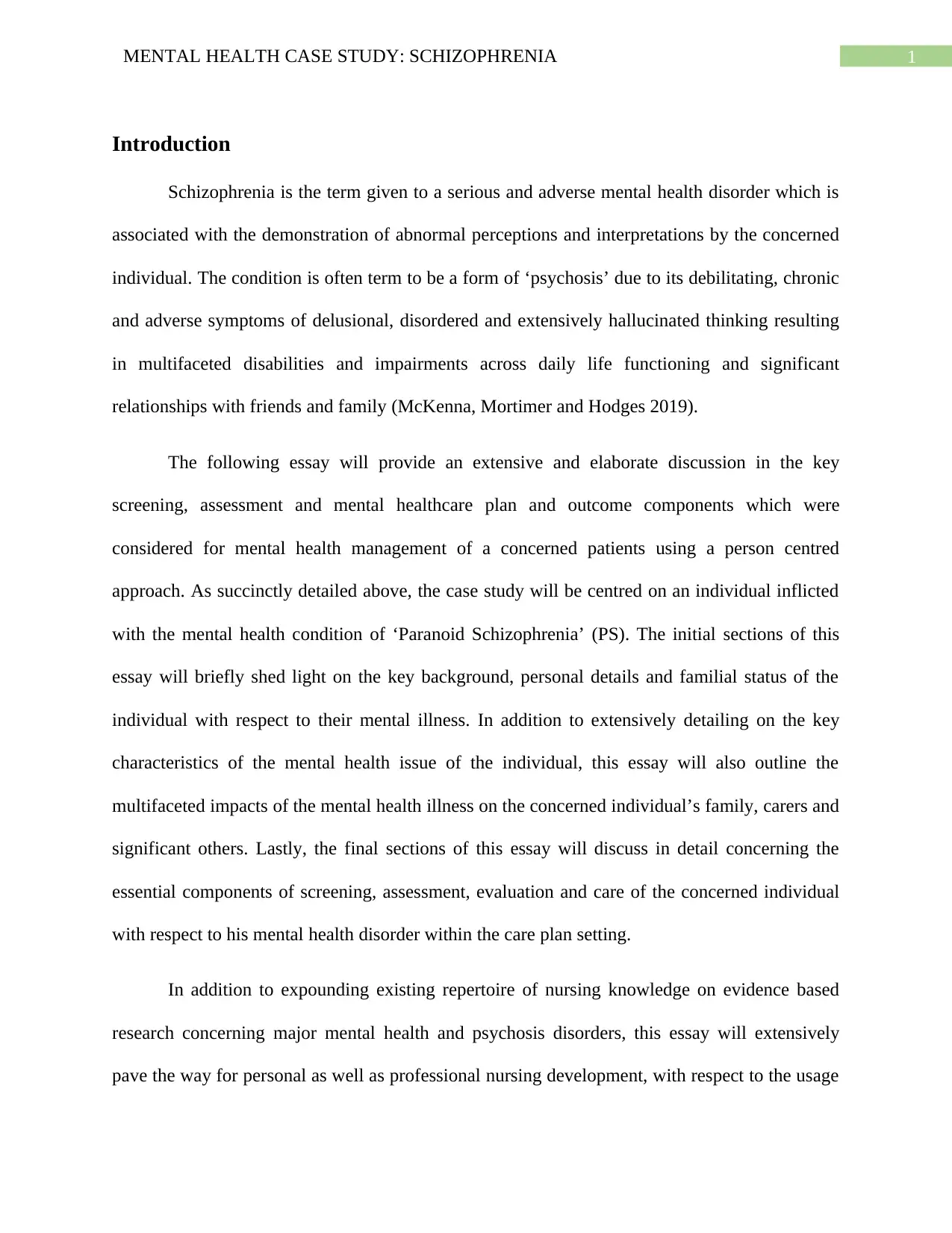
1MENTAL HEALTH CASE STUDY: SCHIZOPHRENIA
Introduction
Schizophrenia is the term given to a serious and adverse mental health disorder which is
associated with the demonstration of abnormal perceptions and interpretations by the concerned
individual. The condition is often term to be a form of ‘psychosis’ due to its debilitating, chronic
and adverse symptoms of delusional, disordered and extensively hallucinated thinking resulting
in multifaceted disabilities and impairments across daily life functioning and significant
relationships with friends and family (McKenna, Mortimer and Hodges 2019).
The following essay will provide an extensive and elaborate discussion in the key
screening, assessment and mental healthcare plan and outcome components which were
considered for mental health management of a concerned patients using a person centred
approach. As succinctly detailed above, the case study will be centred on an individual inflicted
with the mental health condition of ‘Paranoid Schizophrenia’ (PS). The initial sections of this
essay will briefly shed light on the key background, personal details and familial status of the
individual with respect to their mental illness. In addition to extensively detailing on the key
characteristics of the mental health issue of the individual, this essay will also outline the
multifaceted impacts of the mental health illness on the concerned individual’s family, carers and
significant others. Lastly, the final sections of this essay will discuss in detail concerning the
essential components of screening, assessment, evaluation and care of the concerned individual
with respect to his mental health disorder within the care plan setting.
In addition to expounding existing repertoire of nursing knowledge on evidence based
research concerning major mental health and psychosis disorders, this essay will extensively
pave the way for personal as well as professional nursing development, with respect to the usage
Introduction
Schizophrenia is the term given to a serious and adverse mental health disorder which is
associated with the demonstration of abnormal perceptions and interpretations by the concerned
individual. The condition is often term to be a form of ‘psychosis’ due to its debilitating, chronic
and adverse symptoms of delusional, disordered and extensively hallucinated thinking resulting
in multifaceted disabilities and impairments across daily life functioning and significant
relationships with friends and family (McKenna, Mortimer and Hodges 2019).
The following essay will provide an extensive and elaborate discussion in the key
screening, assessment and mental healthcare plan and outcome components which were
considered for mental health management of a concerned patients using a person centred
approach. As succinctly detailed above, the case study will be centred on an individual inflicted
with the mental health condition of ‘Paranoid Schizophrenia’ (PS). The initial sections of this
essay will briefly shed light on the key background, personal details and familial status of the
individual with respect to their mental illness. In addition to extensively detailing on the key
characteristics of the mental health issue of the individual, this essay will also outline the
multifaceted impacts of the mental health illness on the concerned individual’s family, carers and
significant others. Lastly, the final sections of this essay will discuss in detail concerning the
essential components of screening, assessment, evaluation and care of the concerned individual
with respect to his mental health disorder within the care plan setting.
In addition to expounding existing repertoire of nursing knowledge on evidence based
research concerning major mental health and psychosis disorders, this essay will extensively
pave the way for personal as well as professional nursing development, with respect to the usage
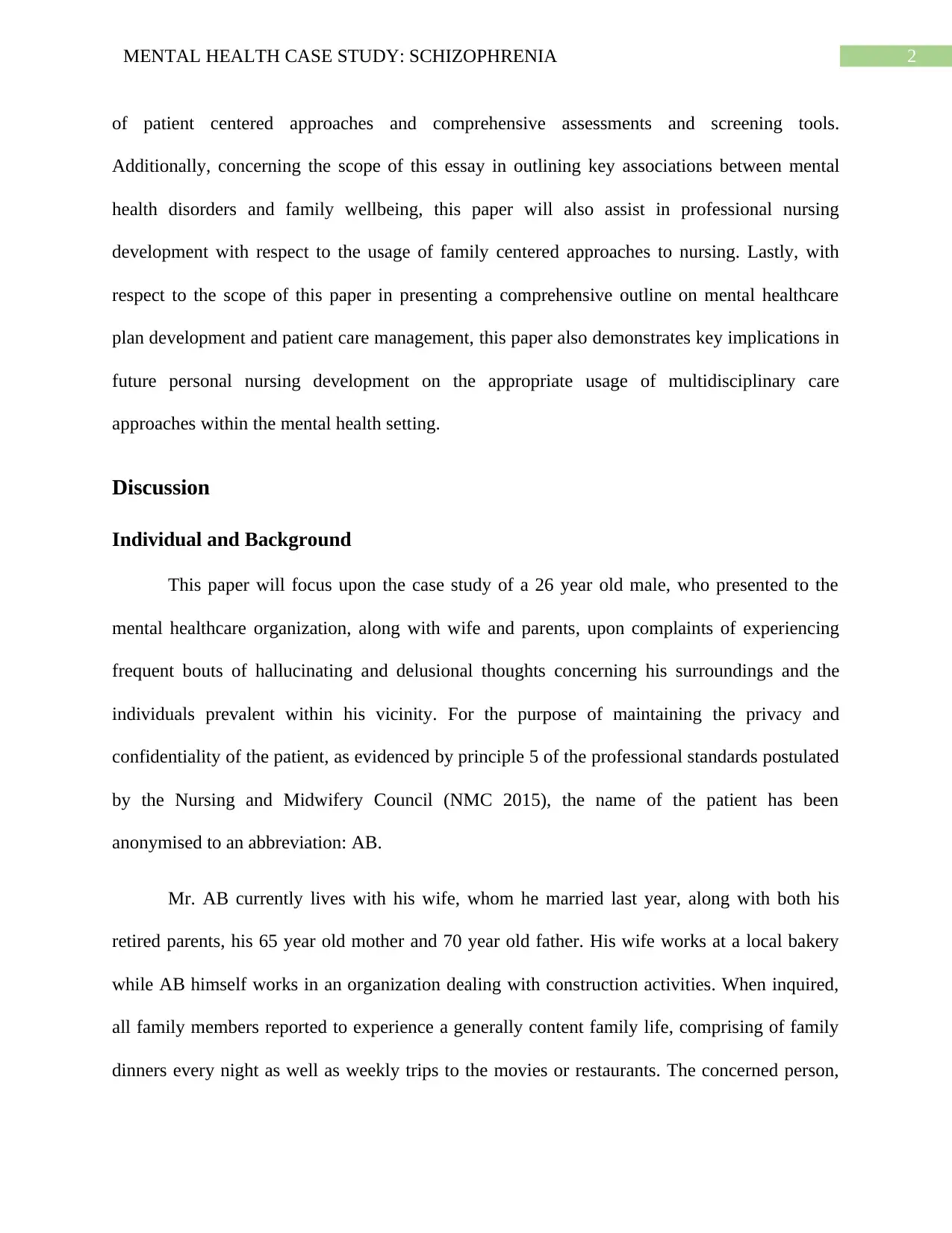
2MENTAL HEALTH CASE STUDY: SCHIZOPHRENIA
of patient centered approaches and comprehensive assessments and screening tools.
Additionally, concerning the scope of this essay in outlining key associations between mental
health disorders and family wellbeing, this paper will also assist in professional nursing
development with respect to the usage of family centered approaches to nursing. Lastly, with
respect to the scope of this paper in presenting a comprehensive outline on mental healthcare
plan development and patient care management, this paper also demonstrates key implications in
future personal nursing development on the appropriate usage of multidisciplinary care
approaches within the mental health setting.
Discussion
Individual and Background
This paper will focus upon the case study of a 26 year old male, who presented to the
mental healthcare organization, along with wife and parents, upon complaints of experiencing
frequent bouts of hallucinating and delusional thoughts concerning his surroundings and the
individuals prevalent within his vicinity. For the purpose of maintaining the privacy and
confidentiality of the patient, as evidenced by principle 5 of the professional standards postulated
by the Nursing and Midwifery Council (NMC 2015), the name of the patient has been
anonymised to an abbreviation: AB.
Mr. AB currently lives with his wife, whom he married last year, along with both his
retired parents, his 65 year old mother and 70 year old father. His wife works at a local bakery
while AB himself works in an organization dealing with construction activities. When inquired,
all family members reported to experience a generally content family life, comprising of family
dinners every night as well as weekly trips to the movies or restaurants. The concerned person,
of patient centered approaches and comprehensive assessments and screening tools.
Additionally, concerning the scope of this essay in outlining key associations between mental
health disorders and family wellbeing, this paper will also assist in professional nursing
development with respect to the usage of family centered approaches to nursing. Lastly, with
respect to the scope of this paper in presenting a comprehensive outline on mental healthcare
plan development and patient care management, this paper also demonstrates key implications in
future personal nursing development on the appropriate usage of multidisciplinary care
approaches within the mental health setting.
Discussion
Individual and Background
This paper will focus upon the case study of a 26 year old male, who presented to the
mental healthcare organization, along with wife and parents, upon complaints of experiencing
frequent bouts of hallucinating and delusional thoughts concerning his surroundings and the
individuals prevalent within his vicinity. For the purpose of maintaining the privacy and
confidentiality of the patient, as evidenced by principle 5 of the professional standards postulated
by the Nursing and Midwifery Council (NMC 2015), the name of the patient has been
anonymised to an abbreviation: AB.
Mr. AB currently lives with his wife, whom he married last year, along with both his
retired parents, his 65 year old mother and 70 year old father. His wife works at a local bakery
while AB himself works in an organization dealing with construction activities. When inquired,
all family members reported to experience a generally content family life, comprising of family
dinners every night as well as weekly trips to the movies or restaurants. The concerned person,
⊘ This is a preview!⊘
Do you want full access?
Subscribe today to unlock all pages.

Trusted by 1+ million students worldwide
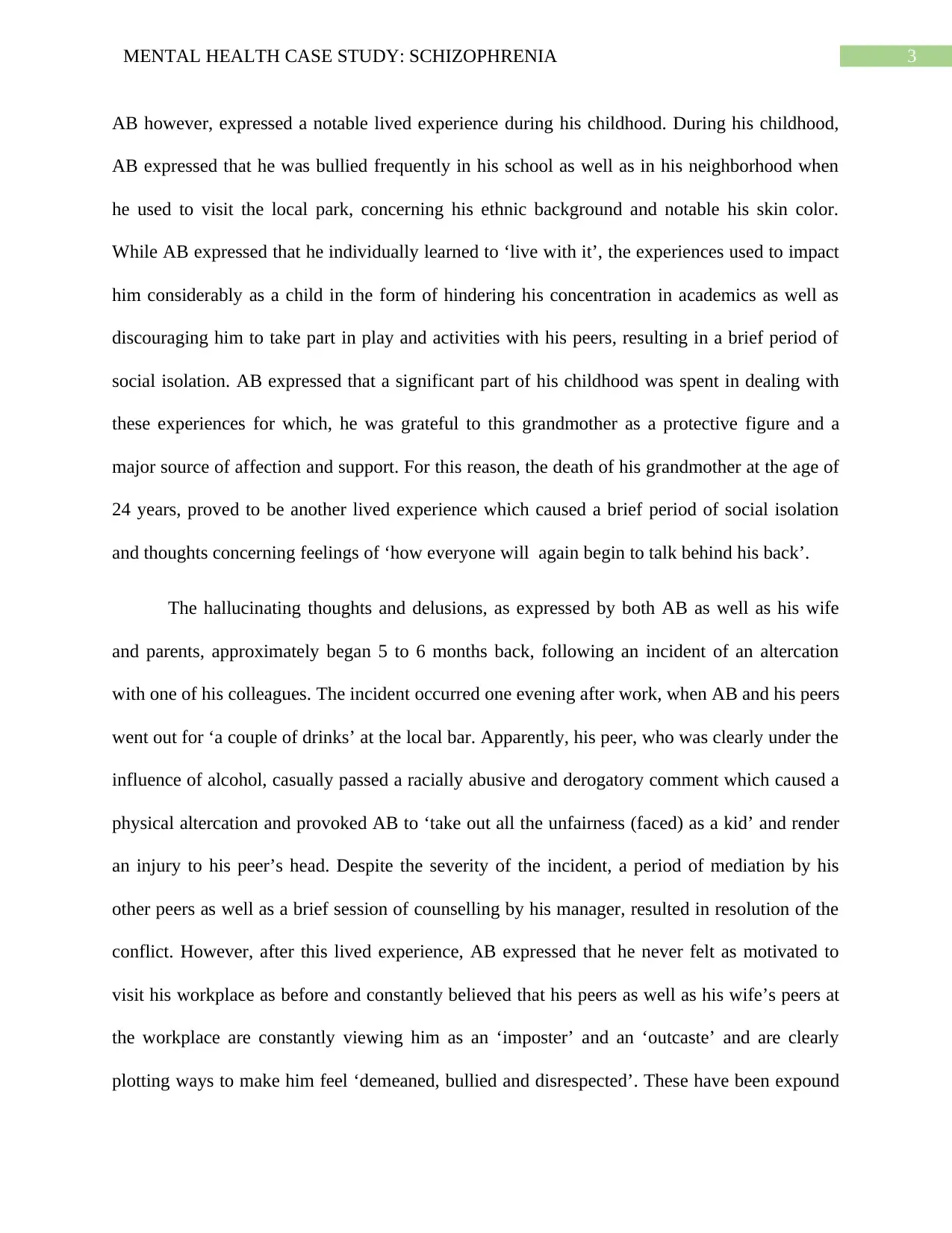
3MENTAL HEALTH CASE STUDY: SCHIZOPHRENIA
AB however, expressed a notable lived experience during his childhood. During his childhood,
AB expressed that he was bullied frequently in his school as well as in his neighborhood when
he used to visit the local park, concerning his ethnic background and notable his skin color.
While AB expressed that he individually learned to ‘live with it’, the experiences used to impact
him considerably as a child in the form of hindering his concentration in academics as well as
discouraging him to take part in play and activities with his peers, resulting in a brief period of
social isolation. AB expressed that a significant part of his childhood was spent in dealing with
these experiences for which, he was grateful to this grandmother as a protective figure and a
major source of affection and support. For this reason, the death of his grandmother at the age of
24 years, proved to be another lived experience which caused a brief period of social isolation
and thoughts concerning feelings of ‘how everyone will again begin to talk behind his back’.
The hallucinating thoughts and delusions, as expressed by both AB as well as his wife
and parents, approximately began 5 to 6 months back, following an incident of an altercation
with one of his colleagues. The incident occurred one evening after work, when AB and his peers
went out for ‘a couple of drinks’ at the local bar. Apparently, his peer, who was clearly under the
influence of alcohol, casually passed a racially abusive and derogatory comment which caused a
physical altercation and provoked AB to ‘take out all the unfairness (faced) as a kid’ and render
an injury to his peer’s head. Despite the severity of the incident, a period of mediation by his
other peers as well as a brief session of counselling by his manager, resulted in resolution of the
conflict. However, after this lived experience, AB expressed that he never felt as motivated to
visit his workplace as before and constantly believed that his peers as well as his wife’s peers at
the workplace are constantly viewing him as an ‘imposter’ and an ‘outcaste’ and are clearly
plotting ways to make him feel ‘demeaned, bullied and disrespected’. These have been expound
AB however, expressed a notable lived experience during his childhood. During his childhood,
AB expressed that he was bullied frequently in his school as well as in his neighborhood when
he used to visit the local park, concerning his ethnic background and notable his skin color.
While AB expressed that he individually learned to ‘live with it’, the experiences used to impact
him considerably as a child in the form of hindering his concentration in academics as well as
discouraging him to take part in play and activities with his peers, resulting in a brief period of
social isolation. AB expressed that a significant part of his childhood was spent in dealing with
these experiences for which, he was grateful to this grandmother as a protective figure and a
major source of affection and support. For this reason, the death of his grandmother at the age of
24 years, proved to be another lived experience which caused a brief period of social isolation
and thoughts concerning feelings of ‘how everyone will again begin to talk behind his back’.
The hallucinating thoughts and delusions, as expressed by both AB as well as his wife
and parents, approximately began 5 to 6 months back, following an incident of an altercation
with one of his colleagues. The incident occurred one evening after work, when AB and his peers
went out for ‘a couple of drinks’ at the local bar. Apparently, his peer, who was clearly under the
influence of alcohol, casually passed a racially abusive and derogatory comment which caused a
physical altercation and provoked AB to ‘take out all the unfairness (faced) as a kid’ and render
an injury to his peer’s head. Despite the severity of the incident, a period of mediation by his
other peers as well as a brief session of counselling by his manager, resulted in resolution of the
conflict. However, after this lived experience, AB expressed that he never felt as motivated to
visit his workplace as before and constantly believed that his peers as well as his wife’s peers at
the workplace are constantly viewing him as an ‘imposter’ and an ‘outcaste’ and are clearly
plotting ways to make him feel ‘demeaned, bullied and disrespected’. These have been expound
Paraphrase This Document
Need a fresh take? Get an instant paraphrase of this document with our AI Paraphraser
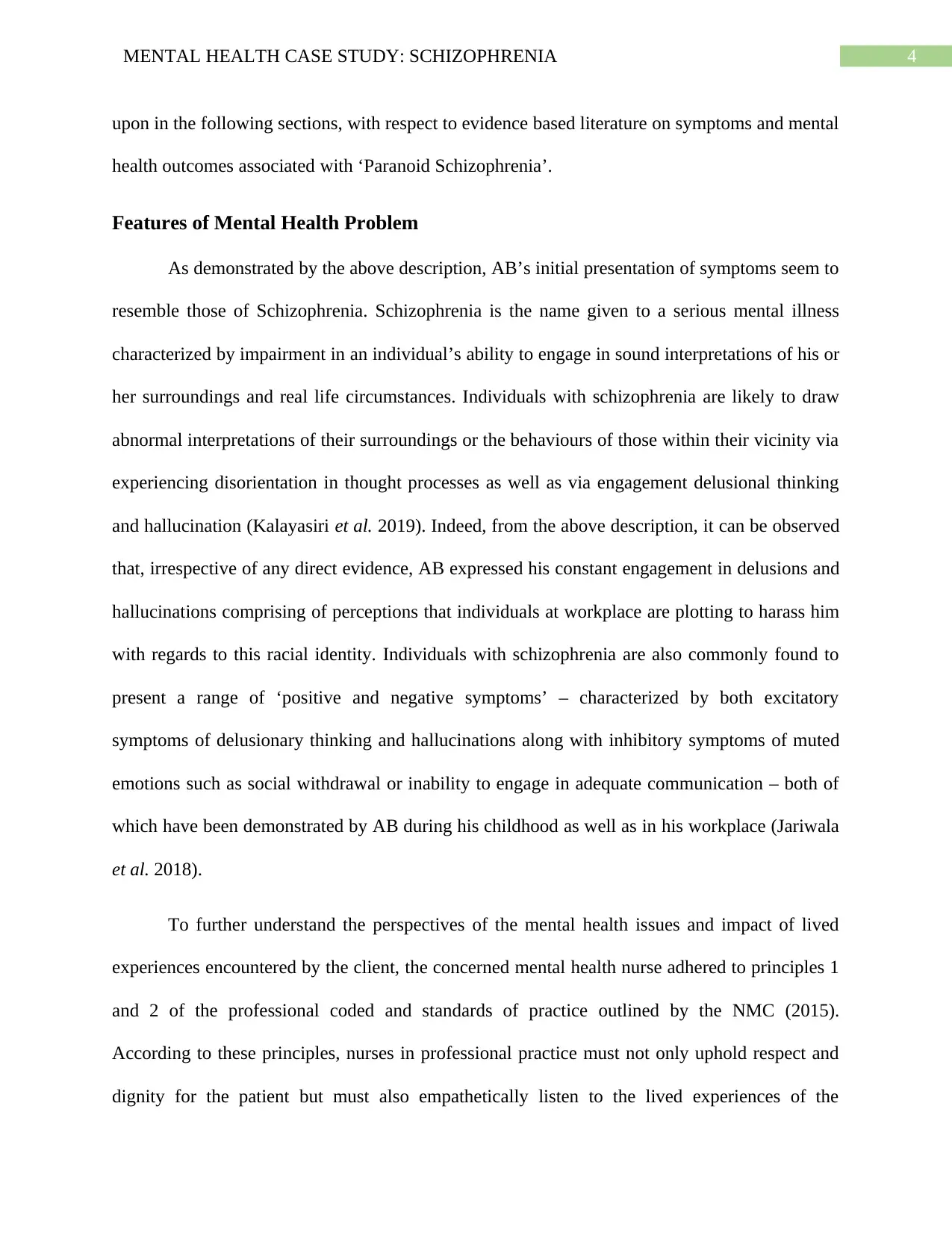
4MENTAL HEALTH CASE STUDY: SCHIZOPHRENIA
upon in the following sections, with respect to evidence based literature on symptoms and mental
health outcomes associated with ‘Paranoid Schizophrenia’.
Features of Mental Health Problem
As demonstrated by the above description, AB’s initial presentation of symptoms seem to
resemble those of Schizophrenia. Schizophrenia is the name given to a serious mental illness
characterized by impairment in an individual’s ability to engage in sound interpretations of his or
her surroundings and real life circumstances. Individuals with schizophrenia are likely to draw
abnormal interpretations of their surroundings or the behaviours of those within their vicinity via
experiencing disorientation in thought processes as well as via engagement delusional thinking
and hallucination (Kalayasiri et al. 2019). Indeed, from the above description, it can be observed
that, irrespective of any direct evidence, AB expressed his constant engagement in delusions and
hallucinations comprising of perceptions that individuals at workplace are plotting to harass him
with regards to this racial identity. Individuals with schizophrenia are also commonly found to
present a range of ‘positive and negative symptoms’ – characterized by both excitatory
symptoms of delusionary thinking and hallucinations along with inhibitory symptoms of muted
emotions such as social withdrawal or inability to engage in adequate communication – both of
which have been demonstrated by AB during his childhood as well as in his workplace (Jariwala
et al. 2018).
To further understand the perspectives of the mental health issues and impact of lived
experiences encountered by the client, the concerned mental health nurse adhered to principles 1
and 2 of the professional coded and standards of practice outlined by the NMC (2015).
According to these principles, nurses in professional practice must not only uphold respect and
dignity for the patient but must also empathetically listen to the lived experiences of the
upon in the following sections, with respect to evidence based literature on symptoms and mental
health outcomes associated with ‘Paranoid Schizophrenia’.
Features of Mental Health Problem
As demonstrated by the above description, AB’s initial presentation of symptoms seem to
resemble those of Schizophrenia. Schizophrenia is the name given to a serious mental illness
characterized by impairment in an individual’s ability to engage in sound interpretations of his or
her surroundings and real life circumstances. Individuals with schizophrenia are likely to draw
abnormal interpretations of their surroundings or the behaviours of those within their vicinity via
experiencing disorientation in thought processes as well as via engagement delusional thinking
and hallucination (Kalayasiri et al. 2019). Indeed, from the above description, it can be observed
that, irrespective of any direct evidence, AB expressed his constant engagement in delusions and
hallucinations comprising of perceptions that individuals at workplace are plotting to harass him
with regards to this racial identity. Individuals with schizophrenia are also commonly found to
present a range of ‘positive and negative symptoms’ – characterized by both excitatory
symptoms of delusionary thinking and hallucinations along with inhibitory symptoms of muted
emotions such as social withdrawal or inability to engage in adequate communication – both of
which have been demonstrated by AB during his childhood as well as in his workplace (Jariwala
et al. 2018).
To further understand the perspectives of the mental health issues and impact of lived
experiences encountered by the client, the concerned mental health nurse adhered to principles 1
and 2 of the professional coded and standards of practice outlined by the NMC (2015).
According to these principles, nurses in professional practice must not only uphold respect and
dignity for the patient but must also empathetically listen to the lived experiences of the
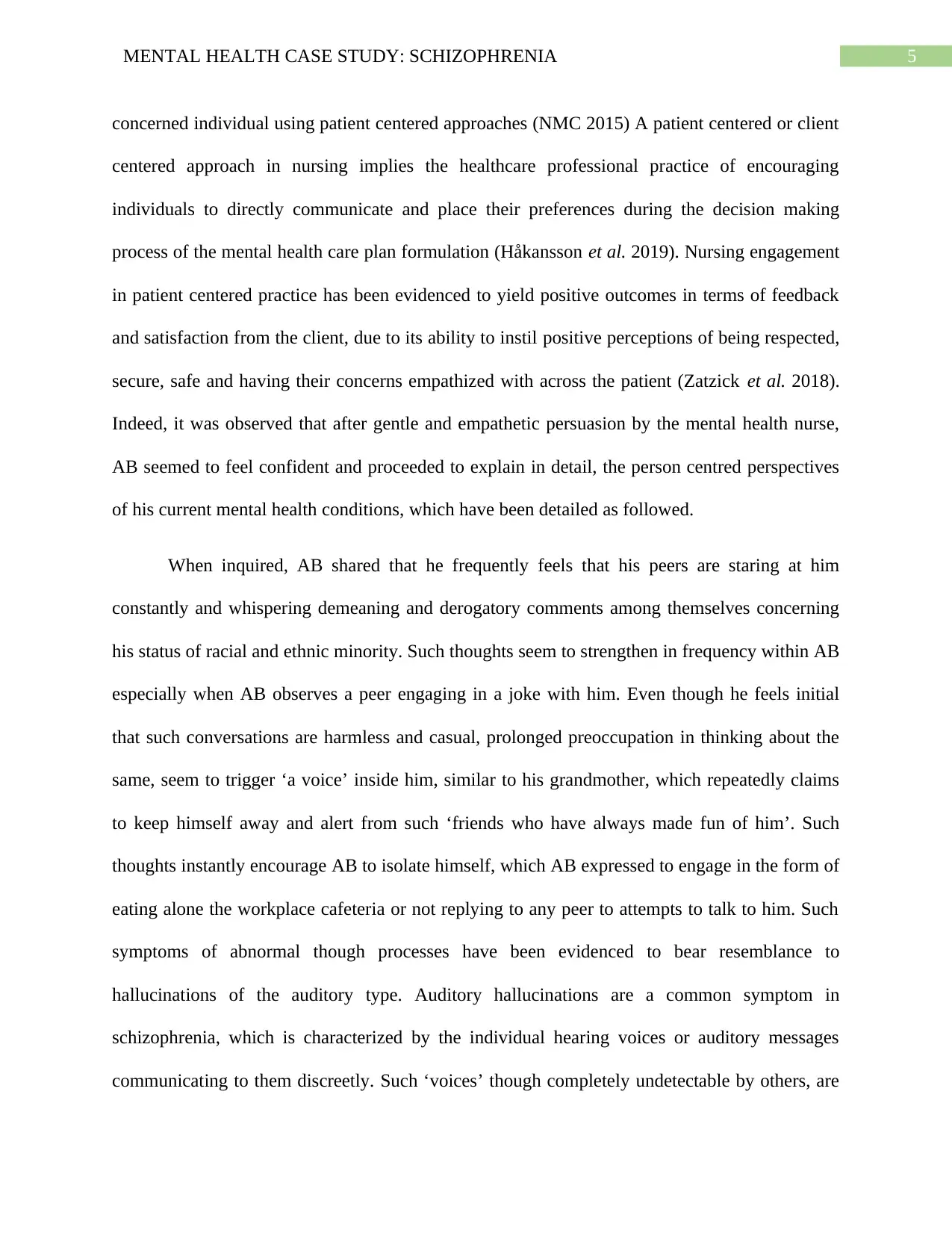
5MENTAL HEALTH CASE STUDY: SCHIZOPHRENIA
concerned individual using patient centered approaches (NMC 2015) A patient centered or client
centered approach in nursing implies the healthcare professional practice of encouraging
individuals to directly communicate and place their preferences during the decision making
process of the mental health care plan formulation (Håkansson et al. 2019). Nursing engagement
in patient centered practice has been evidenced to yield positive outcomes in terms of feedback
and satisfaction from the client, due to its ability to instil positive perceptions of being respected,
secure, safe and having their concerns empathized with across the patient (Zatzick et al. 2018).
Indeed, it was observed that after gentle and empathetic persuasion by the mental health nurse,
AB seemed to feel confident and proceeded to explain in detail, the person centred perspectives
of his current mental health conditions, which have been detailed as followed.
When inquired, AB shared that he frequently feels that his peers are staring at him
constantly and whispering demeaning and derogatory comments among themselves concerning
his status of racial and ethnic minority. Such thoughts seem to strengthen in frequency within AB
especially when AB observes a peer engaging in a joke with him. Even though he feels initial
that such conversations are harmless and casual, prolonged preoccupation in thinking about the
same, seem to trigger ‘a voice’ inside him, similar to his grandmother, which repeatedly claims
to keep himself away and alert from such ‘friends who have always made fun of him’. Such
thoughts instantly encourage AB to isolate himself, which AB expressed to engage in the form of
eating alone the workplace cafeteria or not replying to any peer to attempts to talk to him. Such
symptoms of abnormal though processes have been evidenced to bear resemblance to
hallucinations of the auditory type. Auditory hallucinations are a common symptom in
schizophrenia, which is characterized by the individual hearing voices or auditory messages
communicating to them discreetly. Such ‘voices’ though completely undetectable by others, are
concerned individual using patient centered approaches (NMC 2015) A patient centered or client
centered approach in nursing implies the healthcare professional practice of encouraging
individuals to directly communicate and place their preferences during the decision making
process of the mental health care plan formulation (Håkansson et al. 2019). Nursing engagement
in patient centered practice has been evidenced to yield positive outcomes in terms of feedback
and satisfaction from the client, due to its ability to instil positive perceptions of being respected,
secure, safe and having their concerns empathized with across the patient (Zatzick et al. 2018).
Indeed, it was observed that after gentle and empathetic persuasion by the mental health nurse,
AB seemed to feel confident and proceeded to explain in detail, the person centred perspectives
of his current mental health conditions, which have been detailed as followed.
When inquired, AB shared that he frequently feels that his peers are staring at him
constantly and whispering demeaning and derogatory comments among themselves concerning
his status of racial and ethnic minority. Such thoughts seem to strengthen in frequency within AB
especially when AB observes a peer engaging in a joke with him. Even though he feels initial
that such conversations are harmless and casual, prolonged preoccupation in thinking about the
same, seem to trigger ‘a voice’ inside him, similar to his grandmother, which repeatedly claims
to keep himself away and alert from such ‘friends who have always made fun of him’. Such
thoughts instantly encourage AB to isolate himself, which AB expressed to engage in the form of
eating alone the workplace cafeteria or not replying to any peer to attempts to talk to him. Such
symptoms of abnormal though processes have been evidenced to bear resemblance to
hallucinations of the auditory type. Auditory hallucinations are a common symptom in
schizophrenia, which is characterized by the individual hearing voices or auditory messages
communicating to them discreetly. Such ‘voices’ though completely undetectable by others, are
⊘ This is a preview!⊘
Do you want full access?
Subscribe today to unlock all pages.

Trusted by 1+ million students worldwide
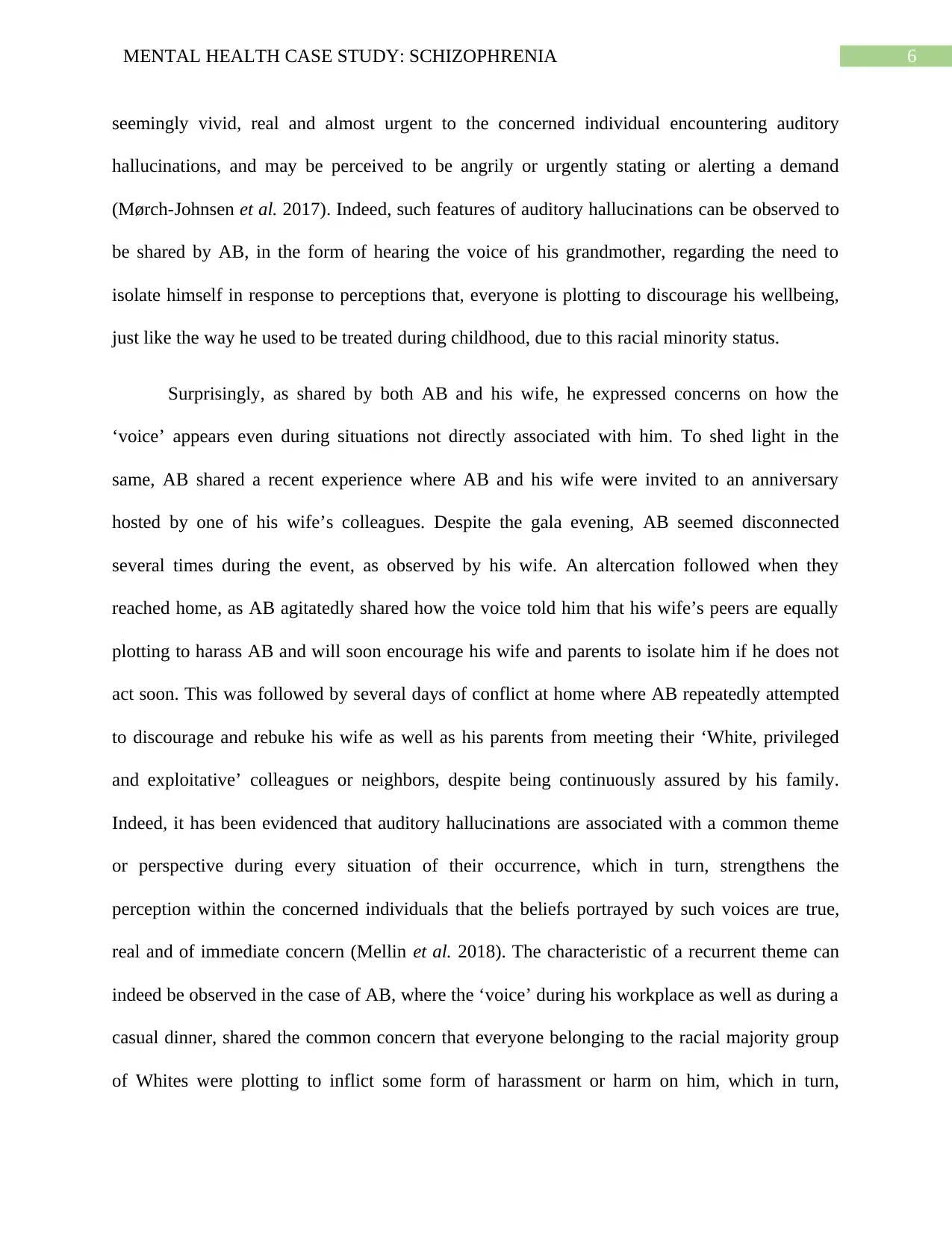
6MENTAL HEALTH CASE STUDY: SCHIZOPHRENIA
seemingly vivid, real and almost urgent to the concerned individual encountering auditory
hallucinations, and may be perceived to be angrily or urgently stating or alerting a demand
(Mørch-Johnsen et al. 2017). Indeed, such features of auditory hallucinations can be observed to
be shared by AB, in the form of hearing the voice of his grandmother, regarding the need to
isolate himself in response to perceptions that, everyone is plotting to discourage his wellbeing,
just like the way he used to be treated during childhood, due to this racial minority status.
Surprisingly, as shared by both AB and his wife, he expressed concerns on how the
‘voice’ appears even during situations not directly associated with him. To shed light in the
same, AB shared a recent experience where AB and his wife were invited to an anniversary
hosted by one of his wife’s colleagues. Despite the gala evening, AB seemed disconnected
several times during the event, as observed by his wife. An altercation followed when they
reached home, as AB agitatedly shared how the voice told him that his wife’s peers are equally
plotting to harass AB and will soon encourage his wife and parents to isolate him if he does not
act soon. This was followed by several days of conflict at home where AB repeatedly attempted
to discourage and rebuke his wife as well as his parents from meeting their ‘White, privileged
and exploitative’ colleagues or neighbors, despite being continuously assured by his family.
Indeed, it has been evidenced that auditory hallucinations are associated with a common theme
or perspective during every situation of their occurrence, which in turn, strengthens the
perception within the concerned individuals that the beliefs portrayed by such voices are true,
real and of immediate concern (Mellin et al. 2018). The characteristic of a recurrent theme can
indeed be observed in the case of AB, where the ‘voice’ during his workplace as well as during a
casual dinner, shared the common concern that everyone belonging to the racial majority group
of Whites were plotting to inflict some form of harassment or harm on him, which in turn,
seemingly vivid, real and almost urgent to the concerned individual encountering auditory
hallucinations, and may be perceived to be angrily or urgently stating or alerting a demand
(Mørch-Johnsen et al. 2017). Indeed, such features of auditory hallucinations can be observed to
be shared by AB, in the form of hearing the voice of his grandmother, regarding the need to
isolate himself in response to perceptions that, everyone is plotting to discourage his wellbeing,
just like the way he used to be treated during childhood, due to this racial minority status.
Surprisingly, as shared by both AB and his wife, he expressed concerns on how the
‘voice’ appears even during situations not directly associated with him. To shed light in the
same, AB shared a recent experience where AB and his wife were invited to an anniversary
hosted by one of his wife’s colleagues. Despite the gala evening, AB seemed disconnected
several times during the event, as observed by his wife. An altercation followed when they
reached home, as AB agitatedly shared how the voice told him that his wife’s peers are equally
plotting to harass AB and will soon encourage his wife and parents to isolate him if he does not
act soon. This was followed by several days of conflict at home where AB repeatedly attempted
to discourage and rebuke his wife as well as his parents from meeting their ‘White, privileged
and exploitative’ colleagues or neighbors, despite being continuously assured by his family.
Indeed, it has been evidenced that auditory hallucinations are associated with a common theme
or perspective during every situation of their occurrence, which in turn, strengthens the
perception within the concerned individuals that the beliefs portrayed by such voices are true,
real and of immediate concern (Mellin et al. 2018). The characteristic of a recurrent theme can
indeed be observed in the case of AB, where the ‘voice’ during his workplace as well as during a
casual dinner, shared the common concern that everyone belonging to the racial majority group
of Whites were plotting to inflict some form of harassment or harm on him, which in turn,
Paraphrase This Document
Need a fresh take? Get an instant paraphrase of this document with our AI Paraphraser
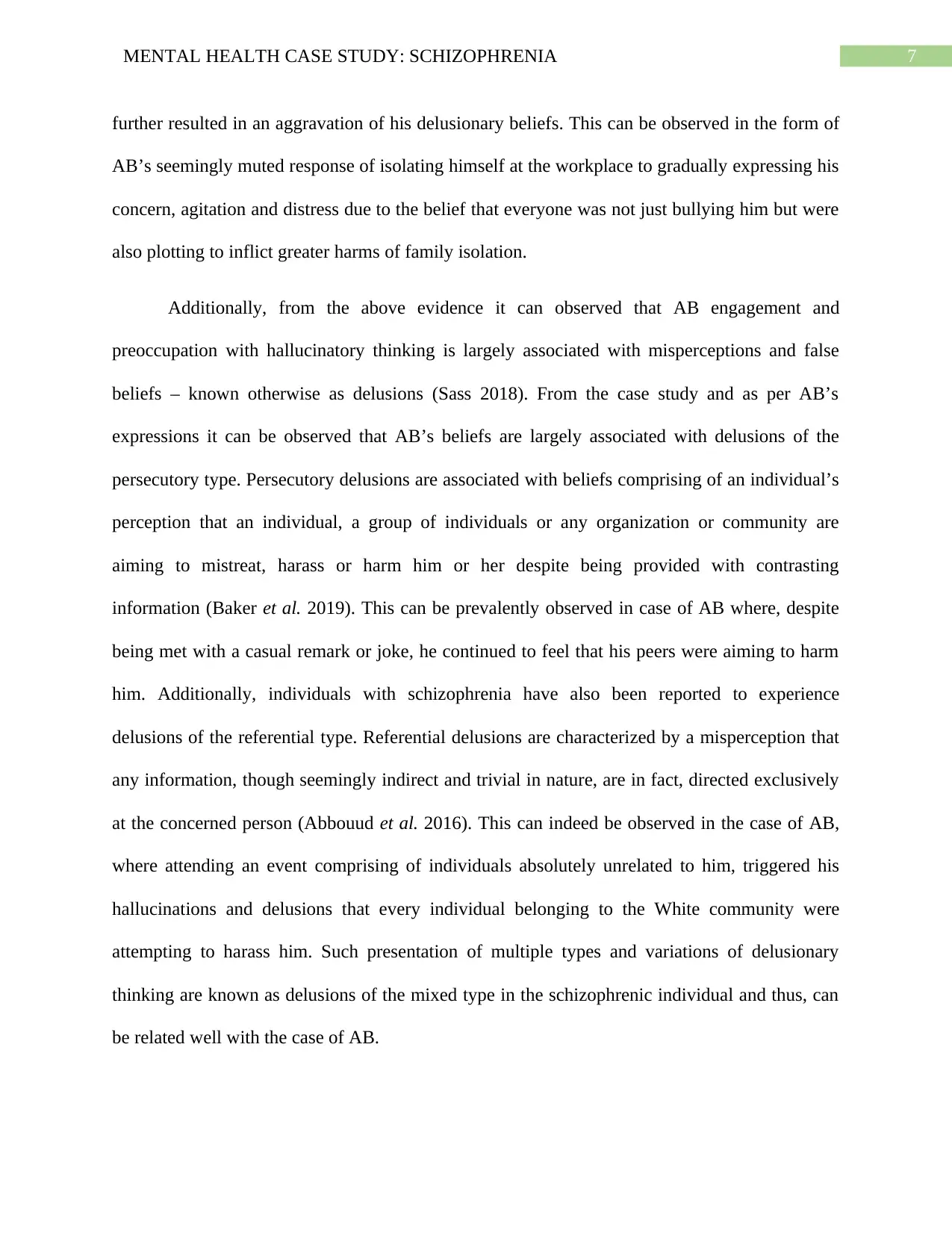
7MENTAL HEALTH CASE STUDY: SCHIZOPHRENIA
further resulted in an aggravation of his delusionary beliefs. This can be observed in the form of
AB’s seemingly muted response of isolating himself at the workplace to gradually expressing his
concern, agitation and distress due to the belief that everyone was not just bullying him but were
also plotting to inflict greater harms of family isolation.
Additionally, from the above evidence it can observed that AB engagement and
preoccupation with hallucinatory thinking is largely associated with misperceptions and false
beliefs – known otherwise as delusions (Sass 2018). From the case study and as per AB’s
expressions it can be observed that AB’s beliefs are largely associated with delusions of the
persecutory type. Persecutory delusions are associated with beliefs comprising of an individual’s
perception that an individual, a group of individuals or any organization or community are
aiming to mistreat, harass or harm him or her despite being provided with contrasting
information (Baker et al. 2019). This can be prevalently observed in case of AB where, despite
being met with a casual remark or joke, he continued to feel that his peers were aiming to harm
him. Additionally, individuals with schizophrenia have also been reported to experience
delusions of the referential type. Referential delusions are characterized by a misperception that
any information, though seemingly indirect and trivial in nature, are in fact, directed exclusively
at the concerned person (Abbouud et al. 2016). This can indeed be observed in the case of AB,
where attending an event comprising of individuals absolutely unrelated to him, triggered his
hallucinations and delusions that every individual belonging to the White community were
attempting to harass him. Such presentation of multiple types and variations of delusionary
thinking are known as delusions of the mixed type in the schizophrenic individual and thus, can
be related well with the case of AB.
further resulted in an aggravation of his delusionary beliefs. This can be observed in the form of
AB’s seemingly muted response of isolating himself at the workplace to gradually expressing his
concern, agitation and distress due to the belief that everyone was not just bullying him but were
also plotting to inflict greater harms of family isolation.
Additionally, from the above evidence it can observed that AB engagement and
preoccupation with hallucinatory thinking is largely associated with misperceptions and false
beliefs – known otherwise as delusions (Sass 2018). From the case study and as per AB’s
expressions it can be observed that AB’s beliefs are largely associated with delusions of the
persecutory type. Persecutory delusions are associated with beliefs comprising of an individual’s
perception that an individual, a group of individuals or any organization or community are
aiming to mistreat, harass or harm him or her despite being provided with contrasting
information (Baker et al. 2019). This can be prevalently observed in case of AB where, despite
being met with a casual remark or joke, he continued to feel that his peers were aiming to harm
him. Additionally, individuals with schizophrenia have also been reported to experience
delusions of the referential type. Referential delusions are characterized by a misperception that
any information, though seemingly indirect and trivial in nature, are in fact, directed exclusively
at the concerned person (Abbouud et al. 2016). This can indeed be observed in the case of AB,
where attending an event comprising of individuals absolutely unrelated to him, triggered his
hallucinations and delusions that every individual belonging to the White community were
attempting to harass him. Such presentation of multiple types and variations of delusionary
thinking are known as delusions of the mixed type in the schizophrenic individual and thus, can
be related well with the case of AB.
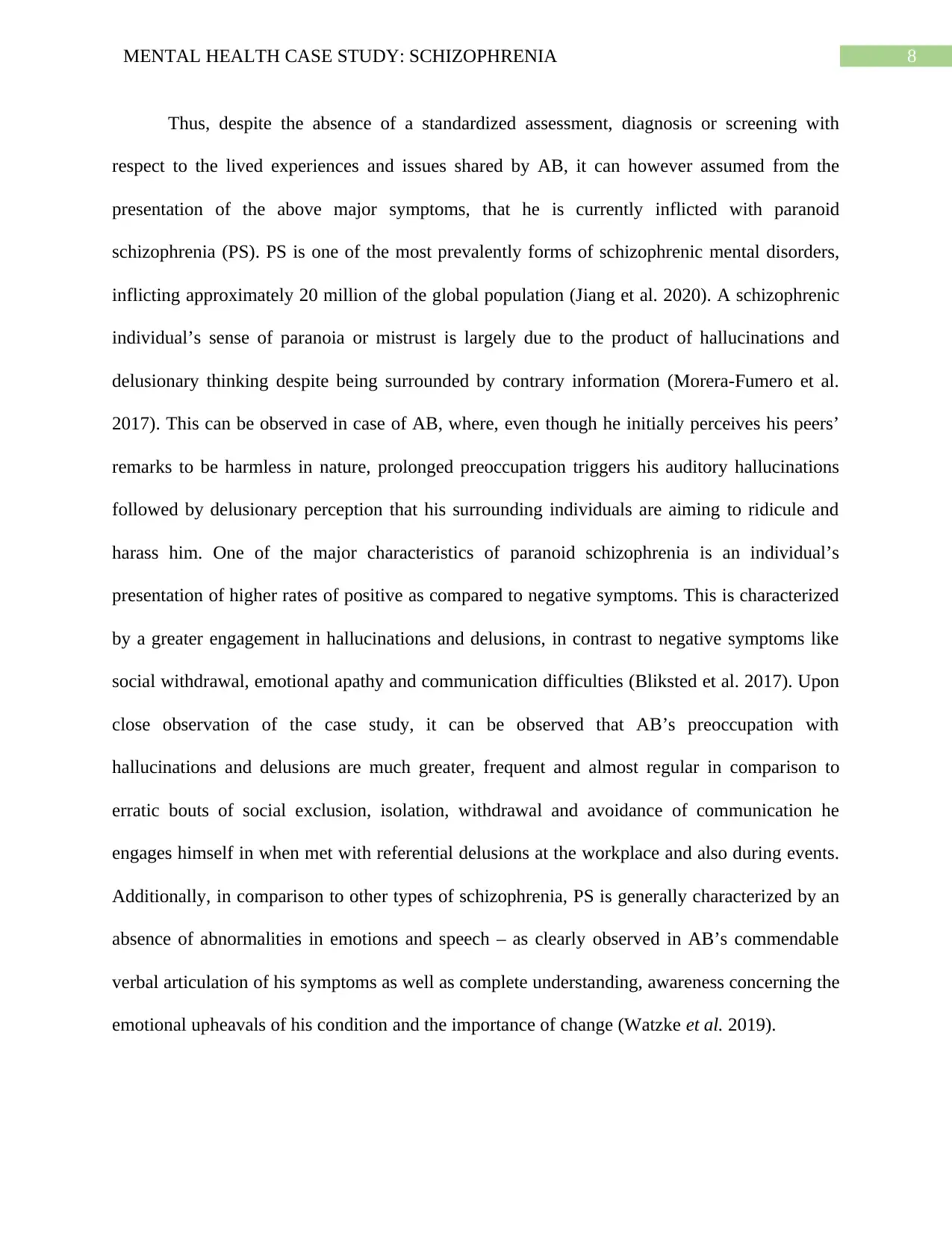
8MENTAL HEALTH CASE STUDY: SCHIZOPHRENIA
Thus, despite the absence of a standardized assessment, diagnosis or screening with
respect to the lived experiences and issues shared by AB, it can however assumed from the
presentation of the above major symptoms, that he is currently inflicted with paranoid
schizophrenia (PS). PS is one of the most prevalently forms of schizophrenic mental disorders,
inflicting approximately 20 million of the global population (Jiang et al. 2020). A schizophrenic
individual’s sense of paranoia or mistrust is largely due to the product of hallucinations and
delusionary thinking despite being surrounded by contrary information (Morera-Fumero et al.
2017). This can be observed in case of AB, where, even though he initially perceives his peers’
remarks to be harmless in nature, prolonged preoccupation triggers his auditory hallucinations
followed by delusionary perception that his surrounding individuals are aiming to ridicule and
harass him. One of the major characteristics of paranoid schizophrenia is an individual’s
presentation of higher rates of positive as compared to negative symptoms. This is characterized
by a greater engagement in hallucinations and delusions, in contrast to negative symptoms like
social withdrawal, emotional apathy and communication difficulties (Bliksted et al. 2017). Upon
close observation of the case study, it can be observed that AB’s preoccupation with
hallucinations and delusions are much greater, frequent and almost regular in comparison to
erratic bouts of social exclusion, isolation, withdrawal and avoidance of communication he
engages himself in when met with referential delusions at the workplace and also during events.
Additionally, in comparison to other types of schizophrenia, PS is generally characterized by an
absence of abnormalities in emotions and speech – as clearly observed in AB’s commendable
verbal articulation of his symptoms as well as complete understanding, awareness concerning the
emotional upheavals of his condition and the importance of change (Watzke et al. 2019).
Thus, despite the absence of a standardized assessment, diagnosis or screening with
respect to the lived experiences and issues shared by AB, it can however assumed from the
presentation of the above major symptoms, that he is currently inflicted with paranoid
schizophrenia (PS). PS is one of the most prevalently forms of schizophrenic mental disorders,
inflicting approximately 20 million of the global population (Jiang et al. 2020). A schizophrenic
individual’s sense of paranoia or mistrust is largely due to the product of hallucinations and
delusionary thinking despite being surrounded by contrary information (Morera-Fumero et al.
2017). This can be observed in case of AB, where, even though he initially perceives his peers’
remarks to be harmless in nature, prolonged preoccupation triggers his auditory hallucinations
followed by delusionary perception that his surrounding individuals are aiming to ridicule and
harass him. One of the major characteristics of paranoid schizophrenia is an individual’s
presentation of higher rates of positive as compared to negative symptoms. This is characterized
by a greater engagement in hallucinations and delusions, in contrast to negative symptoms like
social withdrawal, emotional apathy and communication difficulties (Bliksted et al. 2017). Upon
close observation of the case study, it can be observed that AB’s preoccupation with
hallucinations and delusions are much greater, frequent and almost regular in comparison to
erratic bouts of social exclusion, isolation, withdrawal and avoidance of communication he
engages himself in when met with referential delusions at the workplace and also during events.
Additionally, in comparison to other types of schizophrenia, PS is generally characterized by an
absence of abnormalities in emotions and speech – as clearly observed in AB’s commendable
verbal articulation of his symptoms as well as complete understanding, awareness concerning the
emotional upheavals of his condition and the importance of change (Watzke et al. 2019).
⊘ This is a preview!⊘
Do you want full access?
Subscribe today to unlock all pages.

Trusted by 1+ million students worldwide
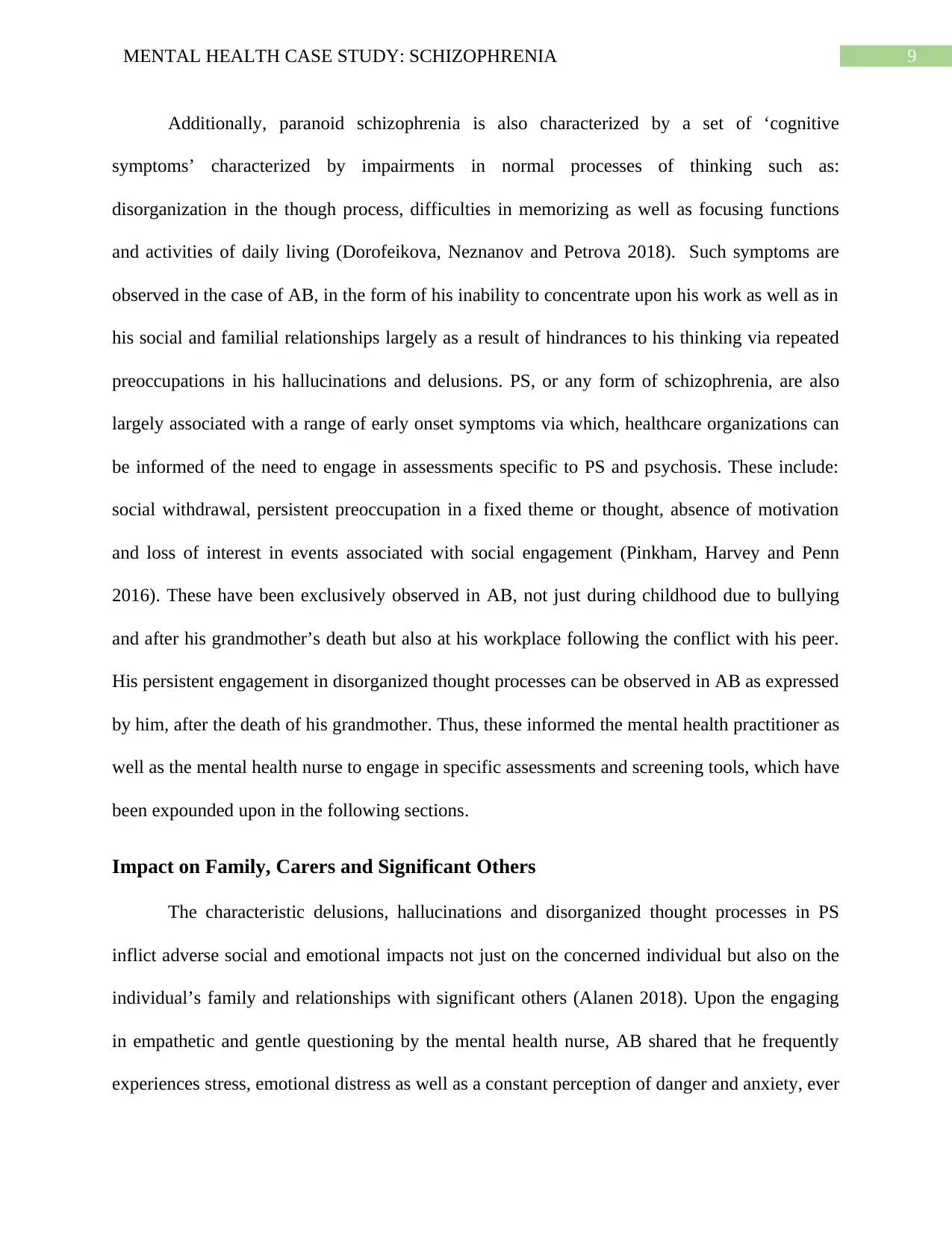
9MENTAL HEALTH CASE STUDY: SCHIZOPHRENIA
Additionally, paranoid schizophrenia is also characterized by a set of ‘cognitive
symptoms’ characterized by impairments in normal processes of thinking such as:
disorganization in the though process, difficulties in memorizing as well as focusing functions
and activities of daily living (Dorofeikova, Neznanov and Petrova 2018). Such symptoms are
observed in the case of AB, in the form of his inability to concentrate upon his work as well as in
his social and familial relationships largely as a result of hindrances to his thinking via repeated
preoccupations in his hallucinations and delusions. PS, or any form of schizophrenia, are also
largely associated with a range of early onset symptoms via which, healthcare organizations can
be informed of the need to engage in assessments specific to PS and psychosis. These include:
social withdrawal, persistent preoccupation in a fixed theme or thought, absence of motivation
and loss of interest in events associated with social engagement (Pinkham, Harvey and Penn
2016). These have been exclusively observed in AB, not just during childhood due to bullying
and after his grandmother’s death but also at his workplace following the conflict with his peer.
His persistent engagement in disorganized thought processes can be observed in AB as expressed
by him, after the death of his grandmother. Thus, these informed the mental health practitioner as
well as the mental health nurse to engage in specific assessments and screening tools, which have
been expounded upon in the following sections.
Impact on Family, Carers and Significant Others
The characteristic delusions, hallucinations and disorganized thought processes in PS
inflict adverse social and emotional impacts not just on the concerned individual but also on the
individual’s family and relationships with significant others (Alanen 2018). Upon the engaging
in empathetic and gentle questioning by the mental health nurse, AB shared that he frequently
experiences stress, emotional distress as well as a constant perception of danger and anxiety, ever
Additionally, paranoid schizophrenia is also characterized by a set of ‘cognitive
symptoms’ characterized by impairments in normal processes of thinking such as:
disorganization in the though process, difficulties in memorizing as well as focusing functions
and activities of daily living (Dorofeikova, Neznanov and Petrova 2018). Such symptoms are
observed in the case of AB, in the form of his inability to concentrate upon his work as well as in
his social and familial relationships largely as a result of hindrances to his thinking via repeated
preoccupations in his hallucinations and delusions. PS, or any form of schizophrenia, are also
largely associated with a range of early onset symptoms via which, healthcare organizations can
be informed of the need to engage in assessments specific to PS and psychosis. These include:
social withdrawal, persistent preoccupation in a fixed theme or thought, absence of motivation
and loss of interest in events associated with social engagement (Pinkham, Harvey and Penn
2016). These have been exclusively observed in AB, not just during childhood due to bullying
and after his grandmother’s death but also at his workplace following the conflict with his peer.
His persistent engagement in disorganized thought processes can be observed in AB as expressed
by him, after the death of his grandmother. Thus, these informed the mental health practitioner as
well as the mental health nurse to engage in specific assessments and screening tools, which have
been expounded upon in the following sections.
Impact on Family, Carers and Significant Others
The characteristic delusions, hallucinations and disorganized thought processes in PS
inflict adverse social and emotional impacts not just on the concerned individual but also on the
individual’s family and relationships with significant others (Alanen 2018). Upon the engaging
in empathetic and gentle questioning by the mental health nurse, AB shared that he frequently
experiences stress, emotional distress as well as a constant perception of danger and anxiety, ever
Paraphrase This Document
Need a fresh take? Get an instant paraphrase of this document with our AI Paraphraser
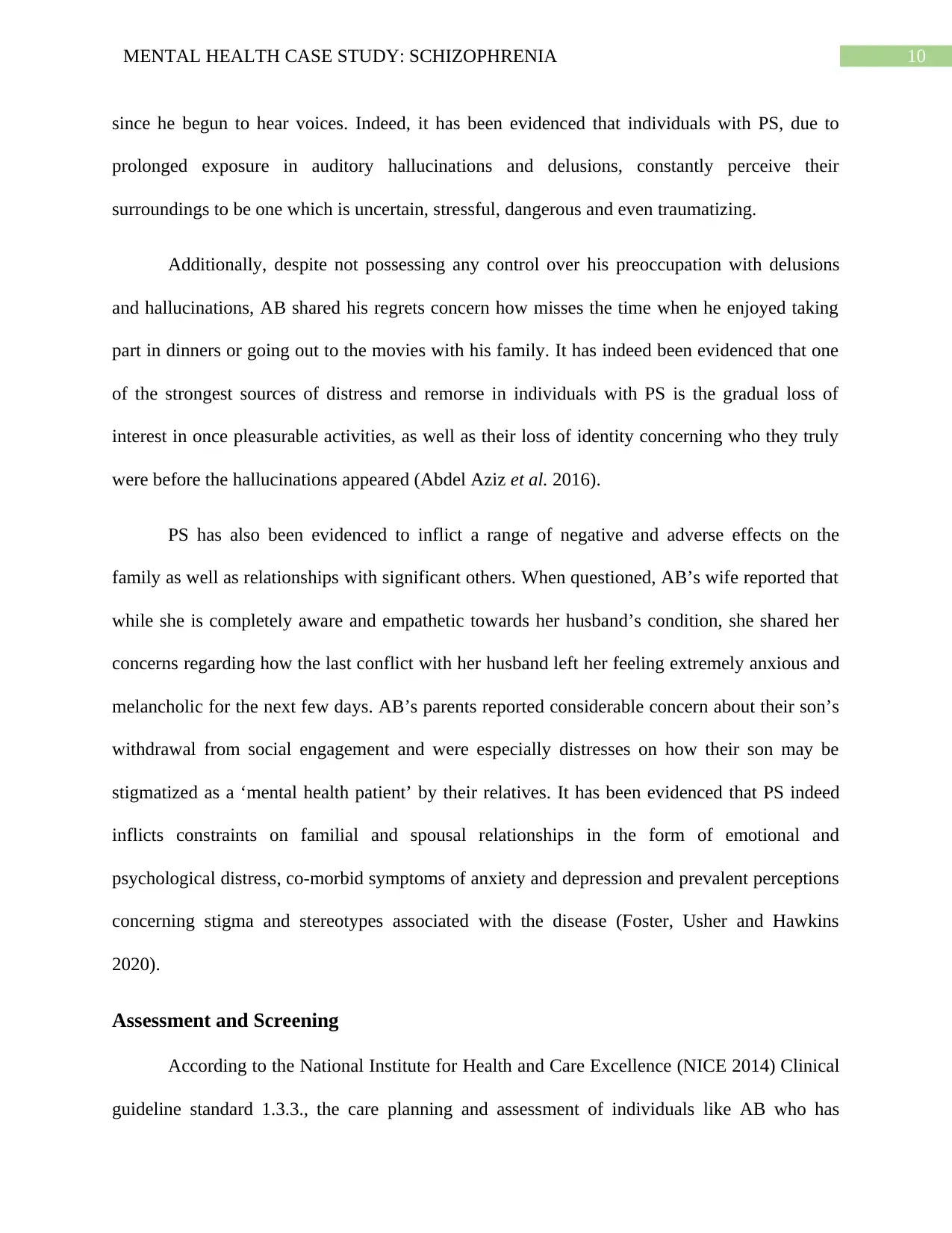
10MENTAL HEALTH CASE STUDY: SCHIZOPHRENIA
since he begun to hear voices. Indeed, it has been evidenced that individuals with PS, due to
prolonged exposure in auditory hallucinations and delusions, constantly perceive their
surroundings to be one which is uncertain, stressful, dangerous and even traumatizing.
Additionally, despite not possessing any control over his preoccupation with delusions
and hallucinations, AB shared his regrets concern how misses the time when he enjoyed taking
part in dinners or going out to the movies with his family. It has indeed been evidenced that one
of the strongest sources of distress and remorse in individuals with PS is the gradual loss of
interest in once pleasurable activities, as well as their loss of identity concerning who they truly
were before the hallucinations appeared (Abdel Aziz et al. 2016).
PS has also been evidenced to inflict a range of negative and adverse effects on the
family as well as relationships with significant others. When questioned, AB’s wife reported that
while she is completely aware and empathetic towards her husband’s condition, she shared her
concerns regarding how the last conflict with her husband left her feeling extremely anxious and
melancholic for the next few days. AB’s parents reported considerable concern about their son’s
withdrawal from social engagement and were especially distresses on how their son may be
stigmatized as a ‘mental health patient’ by their relatives. It has been evidenced that PS indeed
inflicts constraints on familial and spousal relationships in the form of emotional and
psychological distress, co-morbid symptoms of anxiety and depression and prevalent perceptions
concerning stigma and stereotypes associated with the disease (Foster, Usher and Hawkins
2020).
Assessment and Screening
According to the National Institute for Health and Care Excellence (NICE 2014) Clinical
guideline standard 1.3.3., the care planning and assessment of individuals like AB who has
since he begun to hear voices. Indeed, it has been evidenced that individuals with PS, due to
prolonged exposure in auditory hallucinations and delusions, constantly perceive their
surroundings to be one which is uncertain, stressful, dangerous and even traumatizing.
Additionally, despite not possessing any control over his preoccupation with delusions
and hallucinations, AB shared his regrets concern how misses the time when he enjoyed taking
part in dinners or going out to the movies with his family. It has indeed been evidenced that one
of the strongest sources of distress and remorse in individuals with PS is the gradual loss of
interest in once pleasurable activities, as well as their loss of identity concerning who they truly
were before the hallucinations appeared (Abdel Aziz et al. 2016).
PS has also been evidenced to inflict a range of negative and adverse effects on the
family as well as relationships with significant others. When questioned, AB’s wife reported that
while she is completely aware and empathetic towards her husband’s condition, she shared her
concerns regarding how the last conflict with her husband left her feeling extremely anxious and
melancholic for the next few days. AB’s parents reported considerable concern about their son’s
withdrawal from social engagement and were especially distresses on how their son may be
stigmatized as a ‘mental health patient’ by their relatives. It has been evidenced that PS indeed
inflicts constraints on familial and spousal relationships in the form of emotional and
psychological distress, co-morbid symptoms of anxiety and depression and prevalent perceptions
concerning stigma and stereotypes associated with the disease (Foster, Usher and Hawkins
2020).
Assessment and Screening
According to the National Institute for Health and Care Excellence (NICE 2014) Clinical
guideline standard 1.3.3., the care planning and assessment of individuals like AB who has
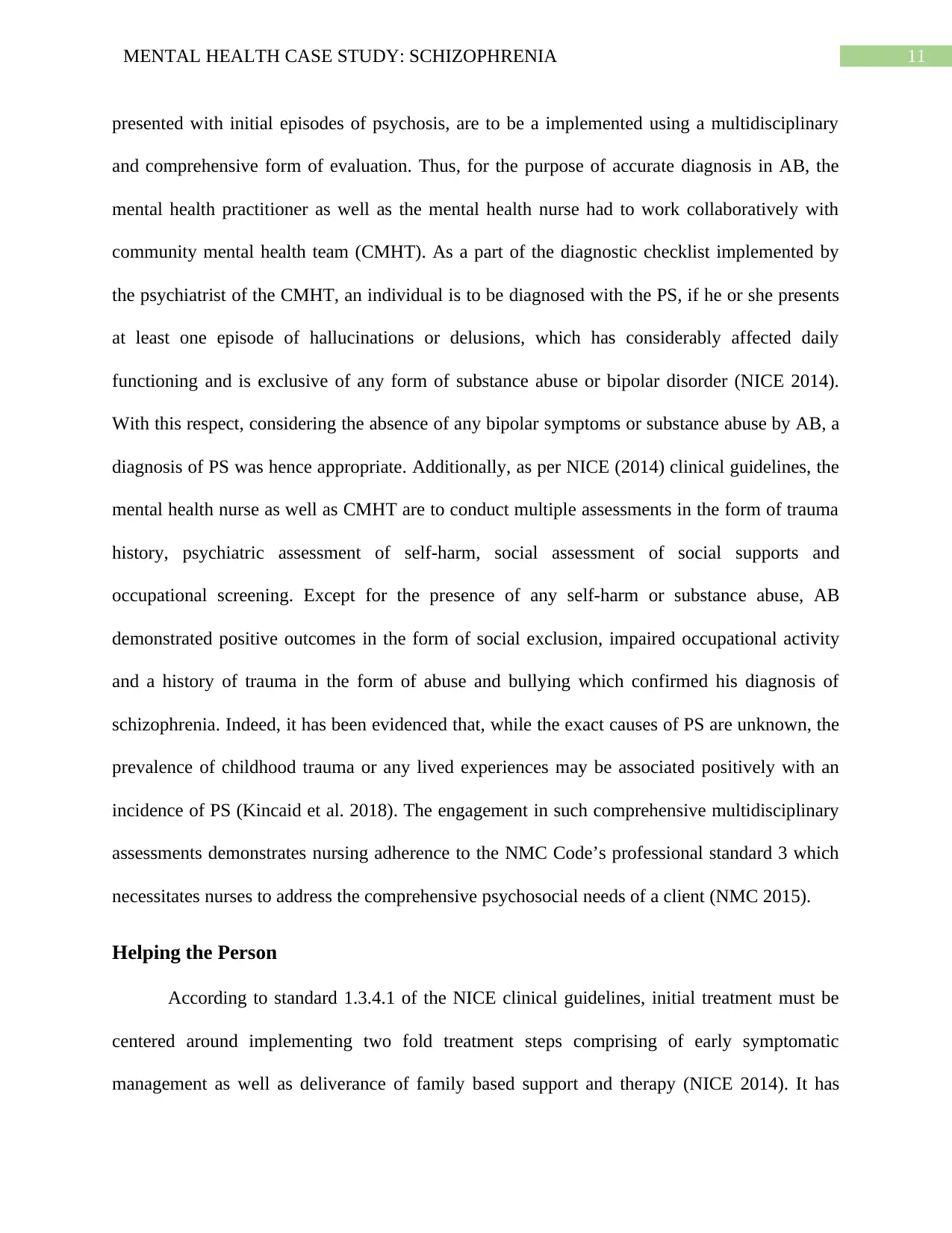
11MENTAL HEALTH CASE STUDY: SCHIZOPHRENIA
presented with initial episodes of psychosis, are to be a implemented using a multidisciplinary
and comprehensive form of evaluation. Thus, for the purpose of accurate diagnosis in AB, the
mental health practitioner as well as the mental health nurse had to work collaboratively with
community mental health team (CMHT). As a part of the diagnostic checklist implemented by
the psychiatrist of the CMHT, an individual is to be diagnosed with the PS, if he or she presents
at least one episode of hallucinations or delusions, which has considerably affected daily
functioning and is exclusive of any form of substance abuse or bipolar disorder (NICE 2014).
With this respect, considering the absence of any bipolar symptoms or substance abuse by AB, a
diagnosis of PS was hence appropriate. Additionally, as per NICE (2014) clinical guidelines, the
mental health nurse as well as CMHT are to conduct multiple assessments in the form of trauma
history, psychiatric assessment of self-harm, social assessment of social supports and
occupational screening. Except for the presence of any self-harm or substance abuse, AB
demonstrated positive outcomes in the form of social exclusion, impaired occupational activity
and a history of trauma in the form of abuse and bullying which confirmed his diagnosis of
schizophrenia. Indeed, it has been evidenced that, while the exact causes of PS are unknown, the
prevalence of childhood trauma or any lived experiences may be associated positively with an
incidence of PS (Kincaid et al. 2018). The engagement in such comprehensive multidisciplinary
assessments demonstrates nursing adherence to the NMC Code’s professional standard 3 which
necessitates nurses to address the comprehensive psychosocial needs of a client (NMC 2015).
Helping the Person
According to standard 1.3.4.1 of the NICE clinical guidelines, initial treatment must be
centered around implementing two fold treatment steps comprising of early symptomatic
management as well as deliverance of family based support and therapy (NICE 2014). It has
presented with initial episodes of psychosis, are to be a implemented using a multidisciplinary
and comprehensive form of evaluation. Thus, for the purpose of accurate diagnosis in AB, the
mental health practitioner as well as the mental health nurse had to work collaboratively with
community mental health team (CMHT). As a part of the diagnostic checklist implemented by
the psychiatrist of the CMHT, an individual is to be diagnosed with the PS, if he or she presents
at least one episode of hallucinations or delusions, which has considerably affected daily
functioning and is exclusive of any form of substance abuse or bipolar disorder (NICE 2014).
With this respect, considering the absence of any bipolar symptoms or substance abuse by AB, a
diagnosis of PS was hence appropriate. Additionally, as per NICE (2014) clinical guidelines, the
mental health nurse as well as CMHT are to conduct multiple assessments in the form of trauma
history, psychiatric assessment of self-harm, social assessment of social supports and
occupational screening. Except for the presence of any self-harm or substance abuse, AB
demonstrated positive outcomes in the form of social exclusion, impaired occupational activity
and a history of trauma in the form of abuse and bullying which confirmed his diagnosis of
schizophrenia. Indeed, it has been evidenced that, while the exact causes of PS are unknown, the
prevalence of childhood trauma or any lived experiences may be associated positively with an
incidence of PS (Kincaid et al. 2018). The engagement in such comprehensive multidisciplinary
assessments demonstrates nursing adherence to the NMC Code’s professional standard 3 which
necessitates nurses to address the comprehensive psychosocial needs of a client (NMC 2015).
Helping the Person
According to standard 1.3.4.1 of the NICE clinical guidelines, initial treatment must be
centered around implementing two fold treatment steps comprising of early symptomatic
management as well as deliverance of family based support and therapy (NICE 2014). It has
⊘ This is a preview!⊘
Do you want full access?
Subscribe today to unlock all pages.

Trusted by 1+ million students worldwide
1 out of 19
Related Documents
Your All-in-One AI-Powered Toolkit for Academic Success.
+13062052269
info@desklib.com
Available 24*7 on WhatsApp / Email
![[object Object]](/_next/static/media/star-bottom.7253800d.svg)
Unlock your academic potential
Copyright © 2020–2025 A2Z Services. All Rights Reserved. Developed and managed by ZUCOL.





